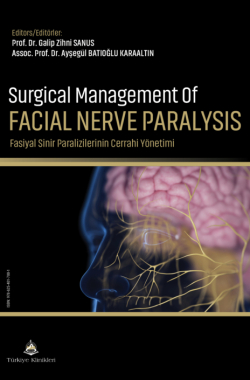Management of the Facial Nerve in Skull Base Surgery: Retrosigmoid Approach
Semih Can ÇETİNTAŞa, Rahşan KEMERDEREa
aİstanbul University-Cerrahpaşa, Cerrahpaşa Faculty of Medicine, Department of Neurosurgery, İstanbul, Türkiye
Çetintaş SC, Kemerdere R. Management of the facial nerve in skull base surgery: Retrosigmoid approach. In: Sanus GZ, Batıoğlu Karaaltın A, eds. Surgical Management of Facial Nerve Paralysis. 1st ed. Ankara: Türkiye Klinikleri; 2022. p.176-80.
ABSTRACT
The facial nerve or CN VII is the seventh of twelve pairs of cranial nerves. It has 3 different nuclei located in the pons. The infranuclear segment of the facial nerve consists of 6 parts. The facial nerve can be affected by malignancies during its course. Many surgical approaches have been developed over time for these lesions concerning facial nerve. Each approach has its own advantages and disadvantages. The retrosigmoid approach is the most convenient and most frequently used approach. In this approach, bone opening is simple and intraoperative orientation is easy. The entire posterior surface of the cerebellopontine segment of facial nerve and part of the inferior and superior borders of the nerve can be exposed. Partial drilling of the posterior wall of internal acoustic canal can expose a limited part of the intracanalicular segment of facial nerve. One of its main advantages is preservation of hearing function.
Keywords: Facial nerve; skull base neoplasms; neurosurgical procedures
Kaynak Göster
Referanslar
- Captier G, Canovas F, Bonnel F, Seignarbieux F. Organization and microscopic anatomy of the adult human facial nerve: anatomical and histological basis for surgery. Plast Reconstr Surg. 2005;115(6):1457-65. [Crossref] [PubMed]
- Bernardo A, Evins AI, visca A, Stieg PE. The intracranial facial nerve as seen through different surgical windows: an extensive anatomosurgical study. Neurosurgery. 2013;72(2 Suppl Operative):ons194- 207; discussion ons207. [Crossref] [PubMed]
- Christopher LH, Slattery WH, Smith EJ, Larian B, Azizzadeh B. Facial nerve management in patients with malignant skull base tumors. J Neurooncol. 2020;150(3):493-500. [Crossref] [PubMed]
- Rhoton AL Jr. The cerebellopontine angle and posterior fossa cranial nerves by the retrosigmoid approach. Neurosurgery. 2000;47(3 Suppl):S93-129. [Crossref] [PubMed]
- Samii M, Matthies C. Management of 1000 vestibular schwannomas (acoustic neuromas): the facial nerve--preservation and restitution of function. Neurosurgery. 1997;40(4):684-94; discussion 694-5. [Crossref] [PubMed]
- Oh T, Nagasawa DT, Fong BM, Trang A, Gopen Q, Parsa AT, et al. Intraoperative neuromonitoring techniques in the surgical management of acoustic neuromas. Neurosurg Focus. 2012;33(3):E6. [Crossref] [PubMed]
- Wanibuchi M, Fukushima T, Friedman AH, Watanabe K, Akiyama y, Mikami T, et al. Hearing preservation surgery for vestibular schwannomas via the retrosigmoid transmeatal approach: surgical tips. Neurosurg Rev. 2014;37(3):431-44; discussion 444. [Crossref] [PubMed]
- Magnan J, Barbieri M, Mora R, Murphy S, Meller R, Bruzzo M, et al. Retrosigmoid approach for small and medium-sized acoustic neuromas. Otol Neurotol. 2002;23(2):141-5. [Crossref] [PubMed]
- Quiñones-Hinojosa A, Chang EF, Lawton MT. The extended retrosigmoid approach: an alternative to radical cranial base approaches for posterior fossa lesions. Neurosurgery. 2006;58(4 Suppl 2):ONS-208-14; discussion ONS-214. [Crossref] [PubMed]
- Tang CT, Kurozumi K, Pillai P, Filipce v, Chiocca EA, Ammirati M. Quantitative analysis of surgical exposure and maneuverability associated with the endoscope and the microscope in the retrosigmoid and various posterior petrosectomy approaches to the petroclival region using computer tomograpy-based frameless stereotaxy. A cadaveric study. Clin Neurol Neurosurg. 2013;115(7):1058-62. [Crossref] [PubMed]
- Chen L, Chen LH, Ling F, Liu yS, Samii M, Samii A. Removal of vestibular schwannoma and facial nerve preservation using small suboccipital retrosigmoid craniotomy. Chin Med J (Engl). 2010;123(3):274-80.
- Ciric I, Zhao JC, Rosenblatt S, Wiet R, O'Shaughnessy B. Suboccipital retrosigmoid approach for removal of vestibular schwannomas: facial nerve function and hearing preservation. Neurosurgery. 2005;56(3):560- 70; discussion 560-70. [Crossref] [PubMed]
- Ansari SF, Terry C, Cohen-Gadol AA. Surgery for vestibular schwannomas: a systematic review of complications by approach. Neurosurg Focus. 2012;33(3):E14. [Crossref] [PubMed]
- Koos WT, Day JD, Matula C, Levy DI. Neurotopographic considerations in the microsurgical treatment of small acoustic neurinomas. J Neurosurg. 1998;88(3):506-12. [Crossref] [PubMed]

